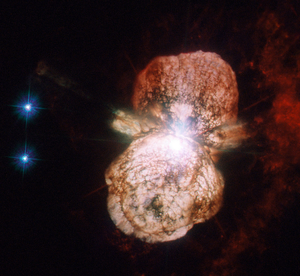Difference between revisions of "Supernova"
(Created page with "==Key Stage 4== right|300px|thumb|Text ===Meaning=== A supernova is the explosion of a red super giant which happens when it has...") |
|||
| (4 intermediate revisions by 2 users not shown) | |||
| Line 1: | Line 1: | ||
==Key Stage 4== | ==Key Stage 4== | ||
| − | [[File:Supernova.png|right|300px|thumb| | + | [[File:Supernova.png|right|300px|thumb|An artist's impression of a [[supernova]].]] |
===Meaning=== | ===Meaning=== | ||
A [[supernova]] is the explosion of a [[Red Super Giant|red super giant]] which happens when it has run out of [[Helium]] to [[Nuclear Fusion|fuse]]. | A [[supernova]] is the explosion of a [[Red Super Giant|red super giant]] which happens when it has run out of [[Helium]] to [[Nuclear Fusion|fuse]]. | ||
| Line 7: | Line 7: | ||
: When a [[massive]] [[star]] runs out of [[Helium]] to [[Nuclear Fusion|fuse]] the core collapses rapidly. Eventually the [[element]]s collide with one another and rebound outwards into an explosion known as a [[supernova]] which can be brighter than all the other [[star]]s in a [[galaxy]] put together. | : When a [[massive]] [[star]] runs out of [[Helium]] to [[Nuclear Fusion|fuse]] the core collapses rapidly. Eventually the [[element]]s collide with one another and rebound outwards into an explosion known as a [[supernova]] which can be brighter than all the other [[star]]s in a [[galaxy]] put together. | ||
: The [[supernova]] will leave behind a core which is either a [[Neutron Star|neutron star]] or a [[Black Hole|black hole]] depending on its [[mass]]. The greater [[mass]] becomes a [[Black Hole|black hole]]. | : The [[supernova]] will leave behind a core which is either a [[Neutron Star|neutron star]] or a [[Black Hole|black hole]] depending on its [[mass]]. The greater [[mass]] becomes a [[Black Hole|black hole]]. | ||
| + | |||
| + | ==Beyond the Curriculum== | ||
| + | {{#ev:youtube|https://www.youtube.com/watch?v=jf_4z4AKwJg}} | ||
| + | |||
| + | {{#ev:youtube|https://www.youtube.com/watch?v=xYxyTZG7APQ}} | ||
| + | |||
| + | ===References=== | ||
| + | ====AQA==== | ||
| + | |||
| + | :[https://www.amazon.co.uk/gp/product/0008158770/ref=as_li_tl?ie=UTF8&camp=1634&creative=6738&creativeASIN=0008158770&linkCode=as2&tag=nrjc-21&linkId=ec31595e720e1529e49876c3866fff6e ''Supernova, pages 285, 287, 291, GCSE Physics; Student Book, Collins, AQA ''] | ||
| + | :[https://www.amazon.co.uk/gp/product/1782945970/ref=as_li_tl?ie=UTF8&camp=1634&creative=6738&creativeASIN=1782945970&linkCode=as2&tag=nrjc-21&linkId=a120d24dcc7cc7a58192069a3aafc1d2 ''Supernovae, page 319, GCSE Physics; The Complete 9-1 Course for AQA, CGP, AQA ''] | ||
| + | :[https://www.amazon.co.uk/gp/product/178294558X/ref=as_li_tl?ie=UTF8&camp=1634&creative=6738&creativeASIN=178294558X&linkCode=as2&tag=nrjc-21&linkId=f0dfb66dafcb0c6e9449e7b1a4ae1ac438 ''Supernovae, pages 100, 102, GCSE Physics; The Revision Guide, CGP, AQA ''] | ||
| + | :[https://www.amazon.co.uk/gp/product/019835939X/ref=as_li_tl?ie=UTF8&camp=1634&creative=6738&creativeASIN=019835939X&linkCode=as2&tag=nrjc-21&linkId=57e96876985fc39b1a3d8a3e3dc238b6 ''Supernovae, pages 234-235, 241, GCSE Physics; Third Edition, Oxford University Press, AQA ''] | ||
| + | :[https://www.amazon.co.uk/gp/product/1471851370/ref=as_li_tl?ie=UTF8&camp=1634&creative=6738&creativeASIN=1471851370&linkCode=as2&tag=nrjc-21&linkId=01c69b0ae058f809cf636033e6ba793e ''Supernovae, pages 252, 253, GCSE Physics, Hodder, AQA ''] | ||
| + | |||
| + | ====Edexcel==== | ||
| + | |||
| + | :[https://www.amazon.co.uk/gp/product/1292120223/ref=as_li_tl?ie=UTF8&camp=1634&creative=6738&creativeASIN=1292120223&linkCode=as2&tag=nrjc-21&linkId=068ecf40278c32406a7f1c6e66751417 ''Supernova, page 123, GCSE Physics, Pearson Edexcel ''] | ||
| + | :[https://www.amazon.co.uk/gp/product/1782948163/ref=as_li_tl?ie=UTF8&camp=1634&creative=6738&creativeASIN=1782948163&linkCode=as2&tag=nrjc-21&linkId=0fdbfd5dd397d6e24a9dfb250f08587f ''Supernovae, page 188, GCSE Physics, CGP, Edexcel ''] | ||
Latest revision as of 11:50, 29 November 2019
Contents
Key Stage 4

An artist's impression of a supernova.
Meaning
A supernova is the explosion of a red super giant which happens when it has run out of Helium to fuse.
About Supernovae
- When a massive star runs out of Helium to fuse the core collapses rapidly. Eventually the elements collide with one another and rebound outwards into an explosion known as a supernova which can be brighter than all the other stars in a galaxy put together.
- The supernova will leave behind a core which is either a neutron star or a black hole depending on its mass. The greater mass becomes a black hole.
Beyond the Curriculum
References
AQA
- Supernova, pages 285, 287, 291, GCSE Physics; Student Book, Collins, AQA
- Supernovae, page 319, GCSE Physics; The Complete 9-1 Course for AQA, CGP, AQA
- Supernovae, pages 100, 102, GCSE Physics; The Revision Guide, CGP, AQA
- Supernovae, pages 234-235, 241, GCSE Physics; Third Edition, Oxford University Press, AQA
- Supernovae, pages 252, 253, GCSE Physics, Hodder, AQA